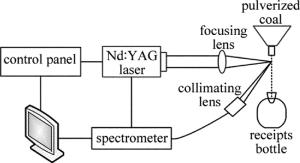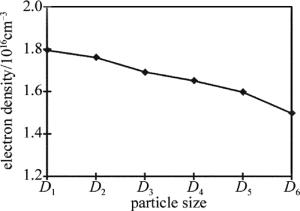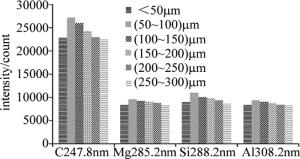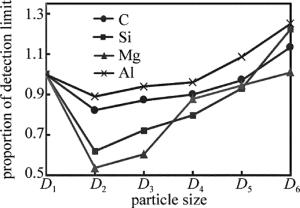HTML
-
激光诱导击穿光谱(laser-induced breakdown spectroscopy,LIBS)技术是基于等离子体发射光谱的定性定量分析技术。自20世纪60年代首次提出以来,因其具有样品制备简单、多元素、同步快速测量等优势,已被广泛地应用于矿产、冶金和燃煤等工业领域[1]。但是LIBS检测精确度易受环境、检测对象物理化学特性等因素的干扰,国内外学者针对检测对象特性影响测量精度的各种因素做了大量的研究工作[2]。在煤质快速检测方面,XIE等人[3]研究煤粉的物理形态对激光诱导发射光谱的基体效应影响时指出,适中的煤粉尺寸和样品密度利于光谱分析的效果优化。YAO等人[4]分析了样品形态对燃煤的激光烧蚀特性影响,结果表明,燃煤的激光诱导等离子体特性会随着燃煤形态的不同而变化,块状煤样的元素特征谱线强度要比粉状煤样的高,但等离子体温度和电子密度却比粉状煤要低。以往LIBS检测煤质成分大多是将煤粉压片或堆积,这种做法虽然在一定程度上增强了等离子体的信号强度,但是也增加了测试周期,并限制了LIBS在线测量的优势[5]。因此,研究人员尝试将LIBS应用于煤粉的直接测量。GAFT等人[6]利用工厂传送带设计了用于在线监测煤中灰分含量的LIBS检测装置,其测量绝对误差的平均值约为0.5%,符合用户要求。NICOLAS等人[7-8]利用LIBS测量煤的碳元素、灰分的元素成分和含量,证实了LIBS应用于煤灰分在线检测的可行性。ZHENG等人[9]在空气环境下对煤粉流的多种元素经行LIBS检测,发现激光能量在30mJ~60mJ内时更有利于煤粉流多元素检测。ZHANG等人[10-12]从不同的收光角度、焦距点位置、激光参量等因素条件下研究了煤粉颗粒流的激发特性,结果显示,收光角度在30°~50°区间、焦深在0mm处时收集到的等离子体信号更强且稳定。由已有的研究可知,虽然将LIBS技术应用到了煤粉颗粒流的直接检测,但大多数研究是针对LIBS检测技术自身条件而言,关于粒径大小对激光诱导煤粉等离子体特性的影响研究不够多。在煤粉碎过程中,随着粒径的减小,矿物质析出,煤粉的物质组成及物理特性会发生很大的变化[13],会直接影响LIBS检测结果。
本文中以煤粉颗粒流为实验对象,应用LIBS技术对其进行直接检测,着重分析不同粒径条件下激光诱导等离子体的光谱强度、温度、电子密度和元素分析检出限随样品粒径的变化。
-
实验装置简图如图 1所示。该装置中Nd:YAG调Q脉冲激光器,工作波长为1064nm,脉冲宽度为4ns,最大激光能量为100mJ。聚焦透镜直径为50mm,焦距为100mm。双通道光纤光谱仪集成2048像素CCD的探测范围为235nm~380nm和580nm~790nm。螺杆式小型给粉机,实验转速为100r/min。下料装置的下料缩口直径为4mm,重复4次测量下粉量,取其平均量为7.41g·min-1。另外还包括光纤、计算机、收料瓶等。
-
实验中采用褐煤为实验样品,在实验室条件下进行充分研磨,然后用标准筛进行筛分,其结果分为:D1(小于50μm), D2(50μm ~100μm), D3(100μm~150μm), D4(150μm~200μm), D5(200μm ~250μm), D6(250μm ~300μm),共6种粒度煤粉。筛分后的煤样在45℃的干燥箱中干燥6h。
-
实验中所用激光波长1064nm, 脉宽4ns, 能量80.4mJ, 频率1Hz,由光源发出,经聚焦透镜后照射在距下粉口3mm的煤粉颗粒流上形成等离子体。等离子体发射光谱信号经收光镜组收集后(收光角度为45°),由光纤传输至光谱仪进行处理,完成采集和数据存储。为获得良好信噪比的光谱信号,设定CCD的采样门宽为2μs,采样延时为1600ns。每种粒径条件下单次收集光谱数据600个,重复3次。
1.1. 实验装置
1.2. 样品配备
1.3. 实验过程
-
等离子体信号的辐射强度与等离子体的温度T和电子密度有很大关系。在等离子体局部热平衡的条件下,测量谱线强度后,则可以利用Boltzmann曲线法得到等离子体温度[14]。现选取同一通道内的4条Ca原子谱线,从美国国家标准与技术研究院(National Institute of Standards and Technology,NIST)[15]数据库中查得的具体参量(包括跃迁几率An、上能级权重因子gn、能级的激发能量En,n表示电子跃迁的能级)如表 1所示。
wavelength/nm An/108s-1 gn En/eV 315.9 3.10 4 7.047168 317.9 3.60 6 7.049550 393.4 1.47 4 3.150984 396.9 1.40 2 3.123349 Table 1. Spectral line parameters of Ca element
通过对数据处理,计算得到等离子体温度与煤粉粒径的关系如图 2所示。由图 2中可以看出,随着煤粉粒径的增大,等离子体的温度则不断下降。由计算得知,与粒径为D6(250μm~300μm)的煤粉颗粒流等离子体温度相比,粒径分别为D1(小于50μm), D2(50μm~100μm), D3(100μm~150μm), D4(150μm~200μm), D5(200μm~250μm)的煤粉颗粒流等离子体温度分别升高了13.13%, 12.67 %, 9.48%, 3.11%, 0.98%。而在煤粉粒径为D3(100μm~150μm)处等离子温度升高速度最快。
等离子体光谱谱线宽度是等离子体电子密度的函数,其中谱线宽度又与电子展宽和离子展宽有关。由于粒子间相互碰撞形成的Stark宽度决定了离子体的主要光谱线宽,所以作者选用Stark展宽来计算电子密度,其公式如下:
式中,Δλ1/2为特征谱线的半峰全宽;ω为电子碰撞系数;N为电子密度。其中ω通过查询参考文献[16]可知。选用C 247.85nm的原子谱线,计算出激光诱导等离子体的电子密度,如图 3所示。从图 3中可以看出, 随着煤粉粒径的增大,等离子体的电子密度不断下降。与粒径为D6(250μm~300μm)的煤粉颗粒流等离子电子密度相比,粒径为D1(小于50μm)的电子密度高了19.89%。因为随着煤粉粒径变小,单位面积内被激发的煤粉颗粒数量成倍增加,激发有效性升高;同时颗粒间隙变小,有利于热量在等离子体内部扩散,加速自由电子的活动使电离的原子、分子数目增多,电子密度变大。
-
为了定量描述等离子体的光谱强度与煤粉粒径的关系,作者选取其中代表性元素C 247.85nm, Mg 285.27nm, Si 288.15nm, Al 309.27nm 4种元素的特征光谱作为元素分析谱线,绘制激光等离子体发射光谱强度在煤粉粒径为D1(小于50μm), D2(50μm~100μm), D3(100μm~150μm), D4(150μm~200μm), D5(200μm~250μm), D6(250μm~300μm)条件下的变化曲线。
由于测量过程中存在着由激光波动、样品成分分布不均等因数造成的数据波动,所以本文中采用均值法对数据进行处理,将150个数据的均值作为一个数据点来分析。分析得到在不同粒径条件下4种元素的光谱强度如图 4所示。
由于不同元素的光谱强度差异过大,为同图显示多个元素的光谱强度,特做成柱状图。从图中可知,随着粒径的减小,各个元素的光谱强度也随之增大,当煤粉粒径为D2(50μm~100μm)时,C, Mg, Si, Al元素特征光谱强度达到最大,当粒径再减小时,光谱强度反而变小。分析认为,随着粒径的不断减小,形成样品的等离子体密度增强,光谱强度增加,当粒径减小到一定程度后,元素的光谱强度趋于饱和,当粒径再减小时,样品等离子体及烧蚀过程中形成的蒸发物质尤其是灰尘对后继入射激光的吸收、反射、散射作用增强,使光谱强度减弱。
-
检出限(limit of detection, LOD)是光谱检测方法灵敏度体现的重要指标之一。根据国际理论(化学)与应用化学联合会(International Union of Pure and Applied Chemistry,IUPAC)的规定,元素分析的检出限的计算公式为:
式中,S是校正曲线的斜率,Sb是对光谱背景信号进行多次测量的标准偏差,α是常量,一般取值为3。因为不同元素的检出限差异很大,为便于同图分析,将各粒径下各元素检出限与粒径小于50μm的对应元素检出限进行对比。由于正比于谱线强度,因此在对比分析中可认为元素分析的检出限为LLOD=α·Sb/I。则通过计算各样品30次激发时的各元素特征光谱强度Sb/I值,就可以比较不同粒径条件下样品的各元素检出限的大小,结果如图 5所示。随着煤粉颗粒流粒径的增大,分析元素C, Si, Mg, Al的检出限变化趋势相同,先降低后升高,在粒径为D2(50μm~100μm)时,检出限达到最低。此时,最有利于煤粉样品中元素检测。
-
结合图 2、图 3和图 4,随着煤粉粒径的减小,等离子体温度和电子密度都不断增大,而光谱强度在增大到一定程度后反而减小。由等离子体原子发射光谱强度理论,可知当电子从高能级p向低能级q跃迁时,产生的发射光谱强度为:
式中,Apq表示从p能级向q能级跃迁的跃迁几率; h为普朗克常数; ν为谱线频率; gp和go分别为激发态与基态的统计权重; Ep为激发能量; k为玻尔兹曼常数。通过公式可以得知,激发的自由粒子数量N0和等离子体温度T与发射光谱强度成正相关。当等离子体温度较低时,等离子体温度变化对光谱强度的大小起主要作用;当等离子温度达到一定值以后,激发的粒子数量对光谱强度的大小起主要作用。随着煤粉粒径减小,激发的粒子数量反而增加,则等离子体温度升高、电子密度增加,致使光谱强度不断增强。随着电子密度增大,等离子体的共振频率也越大,当等离子体共振频率大于激光频率时,等离子体对激光的反射、屏蔽作用大大加强,导致激发形成等离子体总数量减小。所以当煤粉粒径进一步减小时,等离子体的电子密度增强,此时高温高速的原子,分子碰撞进一步加剧,使温度上升,但由于等离子体的反射,屏蔽作用使后继激光作用在样品表明的有效性降低,使激发的总粒子数量下降,此时,温度升高对光谱强度的增加作用小于激发粒子减少对光谱强度的削弱作用。因此,光谱强度总体呈现下降趋势。
2.1. 不同粒径下等离子体温度和电子密度
2.2. 等离子体光谱分析
2.3. 元素分析检出限
2.4. 实验结果分析
-
为了研究将LIBS直接应用于煤粉颗粒流物质成分检测时,煤粉粒径对等离子体温度、电子密度、光谱强度和元素检出限的影响,选用小于50μm, 50μm ~100μm, 100μm ~150μm, 150μm ~200μm, 200μm ~250μm, 250μm ~300μm的6种粒度煤粉进行对比分析。结果表明:煤粉粒径越小,等离子体温度、电子密度越高的同时,选择适当的煤粉粒径不仅可以提高光谱强度,而且更有利于检测样品中含量低的元素。

 Map
Map









 DownLoad:
DownLoad:



